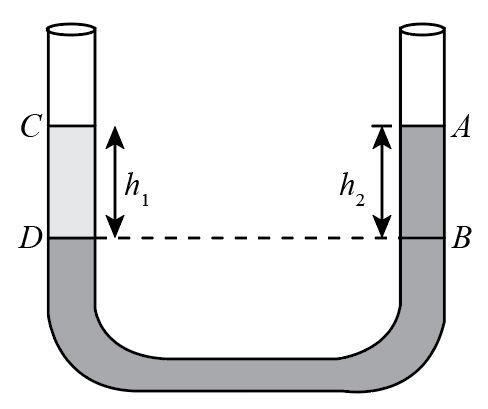
In a U-tube experiment, a column AB of water is balanced by a column CD of paraffin. The relative density of paraffin is:

$\begin{array}{l}
A.\,\,\,\dfrac{{{h_2}}}{{{h_1}}}\\
B.\,\,\,\dfrac{{{h_1}}}{{{h_2}}}\\
C.\,\,\,\dfrac{{{h_2} - {h_1}}}{{{h_1}}}\\
D.\,\,\,\dfrac{{{h_2}}}{{{h_1} + {h_2}}}
\end{array}$

Answer
565.5k+ views
Hint: This question tests us of our knowledge of fluid dynamics. Here we have to use the condition of the U-tube and the condition of a balanced U-tube. And then we will use that condition to find the relative density of paraffin.
Complete step by step answer:For a balanced U-Tube the pressure in both the columns is equal. Therefore, the pressure acting due to the liquids in each column is given as:
$P = {P_0} + \rho gh$, where $\rho $ is the density of the liquid, g is the acceleration due to gravity and h is the height of the liquid column and ${P_0}$ is the atmospheric pressure.
Therefore, the pressure in column one is:
${P_{CD}} = {P_0} + {\rho _p}g{h_1}$
And the pressure in the second column is:
${P_{AB}} = {P_0} + {\rho _w}g{h_2}$
And for the condition of balanced U-Tube these two pressure values would be equal.
Equating the above two equations, we will get:
$\begin{array}{l}
{P_{AB}} = {P_{CD}}\\
{P_0} + {\rho _w}g{h_2} = {P_0} + {\rho _{Paraffin}}g{h_1}
\end{array}$
Cancelling the atmospheric pressure ${P_0}$ from the above expression, we get:
${\rho _w}g{h_2} = {\rho _{Paraffin}}g{h_1}$
Now we have a relation involving the density of the paraffin, water and the heights of the water columns.
Now if we consider the formula of relative density of paraffin it is given below:
\[relative\,density = \dfrac{{{\rho _{paraffin}}}}{{{\rho _w}}}\]
Therefore, if we arrange the relation which we derived we can find the relative density of paraffin:
$\begin{array}{l}
{\rho _w}g{h_2} = {\rho _{Paraffin}}g{h_1}\\
\dfrac{{{\rho _{Paraffin}}}}{{{\rho _w}}} = \dfrac{{g{h_2}}}{{g{h_1}}}\\
\dfrac{{{\rho _{Paraffin}}}}{{{\rho _w}}} = \dfrac{{{h_2}}}{{{h_1}}}\\
relative\,density = \dfrac{{{h_2}}}{{{h_1}}}
\end{array}$
Hence, the relative density is $\dfrac{{{h_2}}}{{{h_1}}}$ and the correct option from the given options is (A.)
Note:In questions like these we have to apply concepts of relative quantities which is the ratio of the quantity with the standard quantity. Also, when calculating pressure in a U-tube one should always add the factor of atmospheric pressure.
Complete step by step answer:For a balanced U-Tube the pressure in both the columns is equal. Therefore, the pressure acting due to the liquids in each column is given as:
$P = {P_0} + \rho gh$, where $\rho $ is the density of the liquid, g is the acceleration due to gravity and h is the height of the liquid column and ${P_0}$ is the atmospheric pressure.
Therefore, the pressure in column one is:
${P_{CD}} = {P_0} + {\rho _p}g{h_1}$
And the pressure in the second column is:
${P_{AB}} = {P_0} + {\rho _w}g{h_2}$
And for the condition of balanced U-Tube these two pressure values would be equal.
Equating the above two equations, we will get:
$\begin{array}{l}
{P_{AB}} = {P_{CD}}\\
{P_0} + {\rho _w}g{h_2} = {P_0} + {\rho _{Paraffin}}g{h_1}
\end{array}$
Cancelling the atmospheric pressure ${P_0}$ from the above expression, we get:
${\rho _w}g{h_2} = {\rho _{Paraffin}}g{h_1}$
Now we have a relation involving the density of the paraffin, water and the heights of the water columns.
Now if we consider the formula of relative density of paraffin it is given below:
\[relative\,density = \dfrac{{{\rho _{paraffin}}}}{{{\rho _w}}}\]
Therefore, if we arrange the relation which we derived we can find the relative density of paraffin:
$\begin{array}{l}
{\rho _w}g{h_2} = {\rho _{Paraffin}}g{h_1}\\
\dfrac{{{\rho _{Paraffin}}}}{{{\rho _w}}} = \dfrac{{g{h_2}}}{{g{h_1}}}\\
\dfrac{{{\rho _{Paraffin}}}}{{{\rho _w}}} = \dfrac{{{h_2}}}{{{h_1}}}\\
relative\,density = \dfrac{{{h_2}}}{{{h_1}}}
\end{array}$
Hence, the relative density is $\dfrac{{{h_2}}}{{{h_1}}}$ and the correct option from the given options is (A.)
Note:In questions like these we have to apply concepts of relative quantities which is the ratio of the quantity with the standard quantity. Also, when calculating pressure in a U-tube one should always add the factor of atmospheric pressure.
Recently Updated Pages
Master Class 12 Economics: Engaging Questions & Answers for Success

Master Class 12 Maths: Engaging Questions & Answers for Success

Master Class 12 Biology: Engaging Questions & Answers for Success

Master Class 12 Physics: Engaging Questions & Answers for Success

Master Class 8 Maths: Engaging Questions & Answers for Success

Class 8 Question and Answer - Your Ultimate Solutions Guide

Trending doubts
What is meant by exothermic and endothermic reactions class 11 chemistry CBSE

Which animal has three hearts class 11 biology CBSE

10 examples of friction in our daily life

One Metric ton is equal to kg A 10000 B 1000 C 100 class 11 physics CBSE

1 Quintal is equal to a 110 kg b 10 kg c 100kg d 1000 class 11 physics CBSE

Difference Between Prokaryotic Cells and Eukaryotic Cells




